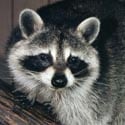4 steps to avoid sharing your home with wildlife
February 20, 2023
Posted by Lake Erie Nature and Science Center

Baby season for wildlife is right around the corner, which means animal moms-to-be will soon start nesting. Animals such as raccoons, squirrels and skunks will be looking for cozy places to build nests for their newborns — and what’s cozier than a nice warm attic or storage shed?
While we may wish wildlife would stick to the wild when it comes to building a home, the fact is that animals have territories and people have properties, and they often overlap. In and around sheds, garages, attics and other structures all seem like attractive places for expecting mothers looking for a secluded, safe space to raise their babies. If sharing your home with a growing family isn’t something you want to do, there are several steps you can take to deter them from moving in.
Don’t provide animals with a food source
Places with plentiful food are very appealing to wildlife — why move out if you’ve got a breakfast buffet right there? Avoid leaving food outdoors, take down any bird feeders, and make sure that your trash cans are secure.
Eliminate potential points of entry to prevent unwanted guests from moving in
Cap any open vents, replace rotting wood and fill any holes in your home’s soffit. Don’t ignore small holes; animals are resourceful and can squeeze into tight spaces, so even if a hole is small, it could still make an easy entrance for a squirrel, mouse or bird.
Make potential den sites inhospitable
Motion-activated floodlights around garages can startle opossums, skunks or raccoons who may be considering making a home underneath. If you suspect an animal has started making a den, keep the area well lit and play loud music in the vicinity. Remember, animals are looking for quiet, secluded spaces for their nests — if you take away those features, they’ll find somewhere else.
Take initiative now
Deterring wildlife before they move in is the best way to manage interactions with nuisance animals. This will prevent you from having to face the challenge of evicting or trapping a young family later. Trapping is often seen as a solution for removing unwanted animals from a property, but at this time of year it can be especially detrimental. Trapping an animal separates them from their babies — babies you might not even know were there. If mom is trapped and removed, the babies are left behind and effectively orphaned. If they are at an age where they are still living in the nest, they will die without their mother’s care.
While there’s no foolproof way to keep animals from nesting in places that are inconvenient to us, taking preventative action can go a long way towards eliminating issues before they even become a problem. By taking these steps now, you can ensure our native wildlife find a good home this spring — a good home somewhere else!

